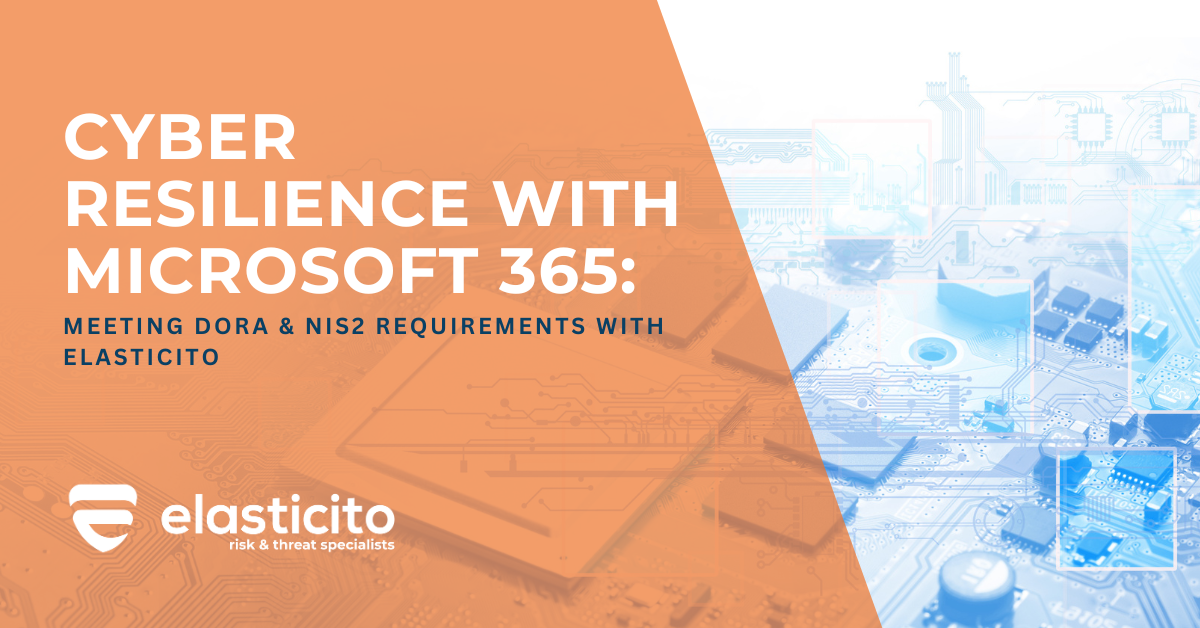Cyber Resilience with Microsoft 365: Meeting DORA & NIS2 Requirements with Elasticito

Executive Summary: The Imperative for Digital Operational Resilience
In an increasingly interconnected digital world, the threat landscape is constantly evolving. Traditional cybersecurity, with its focus on prevention, is no longer sufficient. Organisations must now adopt a posture of cyber resilience. This means having the ability to anticipate, withstand, recover from, and adapt to cyber events. They must do this without interrupting core business functions. This shift is especially critical within the European Union. In the EU, two key laws mandate a high common level of digital operational resilience. These are the Digital Operational Resilience Act (DORA) and the Network and Information Security 2 (NIS2) Directive. The article “Cyber Resilience with Microsoft 365: Meeting DORA & NIS2 Requirements with Elasticito” outlines how organisations can leverage Microsoft 365’s integrated tools. These tools help meet the new security and compliance demands. The article also highlights the crucial distinction of the shared responsibility model. Under this model, Microsoft provides the security of the cloud. However, the customer is responsible for security in the cloud.
Understanding the Regulatory Frameworks:
DORA and NIS2 are complementary regulations that aim to strengthen digital security across the EU.
The Digital Operational Resilience Act (DORA):
DORA specifically targets the financial sector, establishing a harmonised framework for managing ICT risks.
Its key pillars include:
- ICT Risk Management: Organisations must have a robust framework for identifying and assessing risks.
- Incident Reporting: Strict timelines are enforced, with an initial report for major incidents due within 24 hours of detection.
- Resilience Testing: Regular digital operational resilience testing, including Threat-Led Penetration Testing (TLPT) for significant entities.
- Third-Party Risk Management: Financial entities are responsible for managing risks posed by their ICT service providers.
The Network and Information Security 2 (NIS2) Directive:
NIS2 expands on its predecessor, setting cybersecurity standards for a broader range of “essential” and “important” sectors, including energy, transport, health, and digital services.
Its core requirements are:
- Risk Management Measures: Implement appropriate technical and organisational measures.
- Corporate Accountability: Senior management is held explicitly accountable for cybersecurity oversight.
- Incident Reporting: A “early warning” for significant incidents must be provided within 24 hours of awareness.
- Business Continuity & Supply Chain Security: Develop robust plans and ensure the security of the entire supply chain.
Leveraging Microsoft 365 for Compliance:
Microsoft 365 provides a powerful set of tools to address the requirements of both DORA and NIS2.
Foundations of Security:
- Zero Trust: Microsoft’s security solutions are built on the principle of “never trust, always verify.” This involves using Multi-Factor Authentication (MFA) and enforcing the principle of least privilege.
- Microsoft’s 5 Minimum Standards: By implementing these foundational standards—MFA, Zero Trust, modern anti-malware, keeping systems up-to-date, and data protection—organisations can defend against roughly 98% of common attacks.
Key Microsoft 365 Services & Capabilities:
- Microsoft Entra ID: The central hub for identity and access management, enforcing MFA, Conditional Access, and Privileged Identity Management (PIM) to secure user and admin access.
- Microsoft Defender Suite: Provides advanced, AI-powered threat protection and response across endpoints, identities, and applications, with automated capabilities to disrupt attacks.
- Microsoft Sentinel: A cloud-native SIEM/SOAR solution for real-time threat analysis, incident management, and automated response, which is crucial for meeting the strict 24-hour reporting deadlines of both DORA and NIS2.
- Microsoft Purview: A comprehensive suite for data governance and compliance, offering Data Loss Prevention (DLP), Information Protection (classification and encryption), and unified audit logs for detailed reporting.
- Microsoft Intune: Enables endpoint management, ensuring devices are compliant and enforcing app protection policies to secure data even in Bring Your Own Device (BYOD) scenarios.
The Shared Responsibility Model & The Backup Gap:
While Microsoft provides a robust platform, organisations must actively manage their security in the cloud. A significant area of concern and a key compliance gap is data backup and retention.
“The Microsoft 365 Backup Gap: Your Role in Securing Business Data” – Arcserve, a document on securing business data.
- Native Limitations: While Microsoft 365 offers native resilience features like geo-redundancy, versioning, and a 93-day recycle bin, these are often insufficient for meeting stringent regulatory retention periods of 6-7 years.
- The Need for Augmentation: This “backup gap” necessitates the use of third-party backup solutions to ensure long-term, granular data recovery and protection against sophisticated threats like ransomware or malicious insider actions.
A Path to Continuous Compliance:
Compliance with DORA and NIS2 is an ongoing journey that requires a proactive framework.
- Continuous Monitoring: Leverage Microsoft Sentinel and Purview Audit for 24/7 monitoring and logging to demonstrate the continuous effectiveness of your security controls.
- Regular Testing: Conduct frequent security audits and penetration tests to validate your defences against a constantly evolving threat landscape.
- Post-Incident Review: Establish a process for learning from every incident, analysing root causes, and implementing improvements to strengthen your resilience posture.
Conclusion:
DORA and NIS2 represent a clear call to action for organisations operating within the EU. By strategically leveraging Microsoft 365’s powerful security and compliance tools, and by actively addressing areas like the backup gap with third-party solutions, organisations can not only meet these regulatory requirements but also build a truly resilient digital operational framework. A combination of robust technology, disciplined processes and a proactive security culture is the key to safeguarding operations, data, and reputation in the modern threat environment.
Discover how Elasticito automates and orchestrates your cyber security stack to deliver a demonstrable, compliant operational resilience framework.
